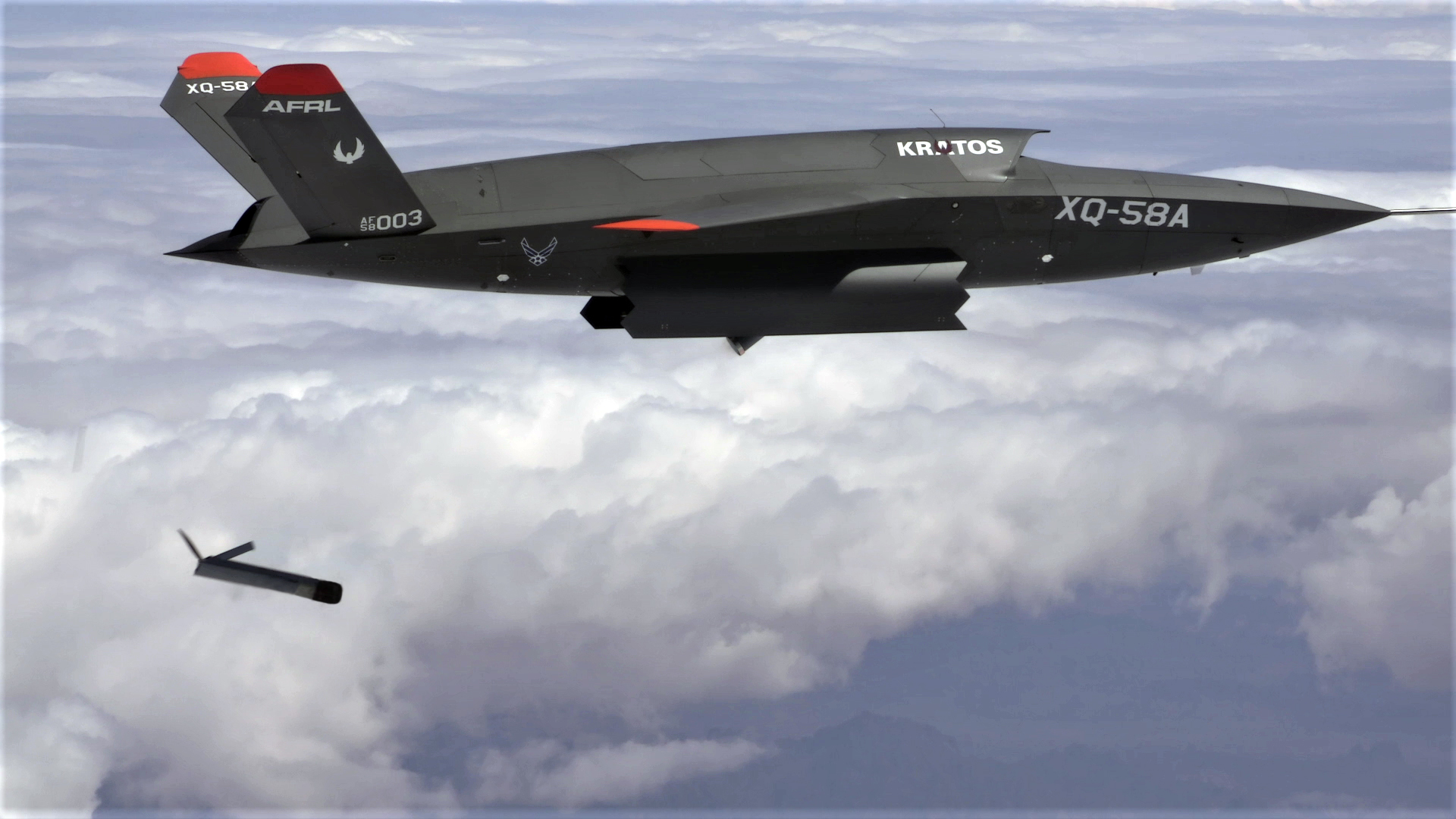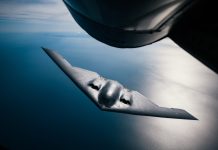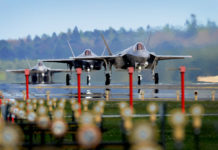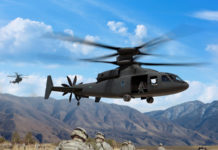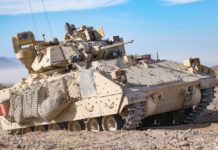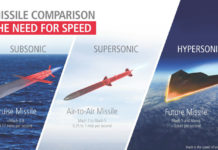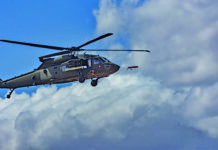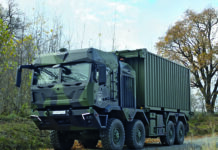Unmanned Aerial Systems (UAS) and other relevant technology (artificial intelligence or AI, wireless data networking, electronic support measures to defeat adversarial electronic warfare) have progressed to a point where UAS are considered capable – in principle – of performing almost any mission currently conducted by crewed aircraft.
As a consequence, numerous armed forces are actively experimenting with manned-unmanned teaming (variably abbreviated as MUM-T or MUMT). By deploying manned and unmanned assets as a unit rather than separately, the uncrewed element maximises its value as a force multiplier, enhancing lethality and survivability in highly contested airspace. Direct control of the UAS can rest with the manned element of the flight, or with a separate airborne, ground or maritime command centre. Over time, advances in AI should permit the uncrewed team elements to perform a significant portion of their missions autonomously. This could ultimately reduce human intervention to input of mission goals, definition of rules-of-engagement, and authorisation of weapons release. In fact, such autonomous capabilities will be essential to the MUM-T concept to prevent human pilots from becoming overwhelmed with additional tasks controlling the UAVs.
Primary applications for the UAS include:
- targeting reconnaissance
- battle-damage assessment for the manned aircraft
- electronic warfare
- data and communications relay/interface between various manned or unmanned platforms
- armed escort
In the latter role, the UAS can either Suppress Enemy Air Defences (SEAD role) in advance of the manned platform, or serve as an external arsenal enabling a single manned plane to attack a significantly larger number of targets per mission.
Rotary Systems US Army MUM-T
The acronym MUM-T was originally coined by the US Army, which conducted the first experiments in 2009. Current efforts center on teaming the AH-64E APACHE GUARDIAN attack helicopter with fixed-wing UAS. MUM-T will also be an integral element of the US Army’s Future Attack/Reconnaissance Aircraft and Future Long Range Assault Aircraft, which are discussed separately in this issue of ESD.
The AH-64E APACHE GUARDIAN is the latest and presumably final iteration of the APACHE attack helicopter family. The “E” variant is specifically designed for the requirements of peer and near-peer warfare. In addition to numerous sensor and avionics upgrades, the new variant has significantly upgraded networking capabilities to support MUM-T operations. Like earlier APACHEs configured for manned-unmanned teaming, it is equipped with the MUMT-2 data link which permits seamless sensor and targeting data transfer between manned aircraft and UAS. The manned helicopter can also relay sensor data from UAVs to ground forces, contributing to a comprehensive situational awareness and operations network.
A planned improvement will replace the MUMT-2 with the MUMT-X data link currently being developed by L-3 Communications. It will include a ROVER 6 transceiver, multiband radio-frequency equipment and a multidirectional antenna capable of transmitting multiple high-definition video streams simultaneously. MUMT-X will increase available bandwidth and extend communications range, enhancing situational awareness and combat efficiency of both the airborne team and friendly forces.
Advancing Capabilities
The US Army conducted its first operational deployment of manned-unmanned teams in 2015, with AH-64s of the 101st Airborne Division successfully integrating with US Air Force MQ-1C UAVs. The unmanned aircraft – which were controlled by ground operators – were able to locate and illuminate targets for APACHEs’ missiles while the manned helicopters remained at standoff-range or raced in for the kill. The teaming resulted in the elimination of multiple mobile targets, some of which were detected while 100 km away from the waiting AH-64.
Since then, increasingly sophisticated and complex operational capabilities have been achieved. The crew of an AH-64E APACHE helicopter can currently control up to three armed MQ-1C GRAY EAGLE UAVs or three unarmed RQ-7B SHADOW UAVs. This includes full control of flight operations (except for take-off and landing, which the UAVs conduct autonomously), sensors and weapons, and constitutes the highest interoperability level (Level 4 Teaming).
Next Manned-Unmanned Teaming Steps
In October 2020, the US Army announced that a new milestone had been reached at the Dugway Proving Ground (DPG) test range. It was the first instance of a three-aircraft team operating together to destroy a target. The team consisted of an AH-64E, an RQ-7B and an MQ-C1. Some 50 km separated the aircraft during the actual engagement. The unarmed RQ-7B reconnaissance UAV detected a target and relayed the coordinates to the pilot of the APACHE. The pilot assumed control of the drone’s laser targeting system and illuminated the target, while directing the MQ-1C to fire a HELLFIRE missile. The successful test was repeated a few days later, this time firing a Small Glide Munition.
“Demonstrating this level of interoperability is a big step forward for MUM-T possibilities,” said Doug McDaniel, a senior engineer with the Rapid Integration and Acceptance Center (RIAC), a tenant organisation at DPG who helped orchestrate the flight tests. “At some point, these kind of cooperative engagements will be used in combat. This is a big first step.” Enabling the manned helicopter to engage targets from beyond line of sight – including from behind visual barriers such as hills or mountains – using UAVs as surrogate sensor and weapons platforms will not only enhance force protection. A single manned crew can cover an area of operations which previously required multiple gunships, permitting a squadron to disperse its manned forces and engage a larger number of enemies in a shorter time.
Several European land forces – including the British and Netherlands armies – are acquiring the AH-64E and will also pursue the MUM-T capability.
South Korea
The concept is being pursued in Asia as well. The South Korean Army’s new Light Armed Helicopter (LAH) and the new SURION Maritime Attack Helicopter (MAH) will both have a MUM-T capability currently being developed by Korea Aerospace Industries (KAI). The development contract between the South Korean Defense Acquisition Program Administration (DAPA) and KAI calls for development of the MUM-T system to be complete by December 2022, with subsequent testing aboard a Surion helicopter. Both manned helicopter types are expected to be paired with domestically developed multimission UAVs.
“The MUM-T will be available in four different modules, each designed for one of the following four roles: reconnaissance, electronic warfare, deception, and suicide missions,” a KAI spokesman said in October 2021 during the ADEX 2021 exposition in Seoul.
Up to four UAVs will be carried aboard the manned LAH in externally mounted launch canisters. A full-scale MAH mock-up presented at ADEX 2021 featured 13 UAVs, including nine mounted inside the aft fuselage. KAI has released an animated video showing the UAVs unfolding wings after launch and deploying as reconnaissance assets, relaying sensor data to an operator in the back of the manned helicopter. When viable targets are identified the operator can convert the UAVs to attack munition mode. According to DAPA, the launch system could be ready for deployment by 2026.
KAI also unveiled a more sophisticated concept during ADEX 2021. An animated video showed an unmanned variant of the LAH which could operate jointly with manned aircraft. The company suggests that several unmanned UAS could deploy together with a single manned helicopter, multiplying firepower and sensor capabilities while reducing risk to human crews. The unmanned LAH could also team with the Korean Army’s AH-64E APACHE GUARDIAN, acting as a scout or neutralising enemy air defence systems in advance of the manned helicopters.
Tactical Fixed Wing Aircraft 8800
A technologically more ambitious concept seeks to pair fixed wing manned and unmanned jet aircraft for joint missions. The United States Air Force (USAF) has taken the lead here.
USAF SKYBORG
USAF’s initiative was originally dubbed the “LOYAL WINGMAN” to reflect the UAS’ support function for manned combat aircraft, but has been redesignated as the SKYBORG programme. The term SKYBORG actually refers to the AI control system being developed for the UAS. The future airframes per se are being developed under the Low-Cost Attritable Airframe Systems or LCAAS programme.
To be clear, the terms “low cost” and “attritable” do not mean that the unmanned aircraft are considered “disposable” assets. The unmanned units will be configured for a service life stretching over several years. Significant investments are being made to develop sophisticated capabilities. However, the estimated acquisition cost of circa US$3M per unit will be significantly lower than those of crewed aircraft with similar mission profiles. This will permit acquisition of a larger number of airframes, and will make loss of aircraft acceptable if the tactical or strategic goal of the mission warrants, or if sacrificing the UAV secures a manned unit. Effectively, “suicide missions” against high value targets will become an option.
Since UAS are configured for a shorter service life, they will not require depot-level maintenance or service life extensions. Aside from the cost savings, the shorter service life also will enhance aircraft capabilities. New UAS will be acquired at shorter intervals, ensuring that incoming airframes (or even new designs) will reflect the very latest technology and operational concepts.
SKYBORG Roadmap
Whichever fuselage design and payload packages are eventually selected, the true key to successful MUM-T integration lies with the SKYBORG AI system being developed by the Air Force Research Laboratory (AFRL). The software suite, which will enable the UAVs’ autonomous flight as well as their flawless response to external control, is formally designated as the SKYBORG AUTONOMY CORE SYSTEM or ACS. The ACS was validated during a multi-months test series in 2021, culminating in participation in the Orange Flag 21-2 Large Force Event in California in June of that year. Operating autonomously during that event, the ACS accomplished basic aviation behaviours and responded to navigational commands, while reacting to geo-fences, adhering to aircraft flight envelopes, and demonstrating coordinated manoeuvring.
During the multi-months validation phase, the software was successfully integrated on two very different UAVs, the Kratos UTAP-22 MAKO and the General Atomics – Aerospace Systems Inc. (GA-ASI) MQ-20. “Flying the SKYBORG ACS on platforms from two different manufacturers demonstrates the portability of the Government-owned autonomy core, unlocking future multi-mission capabilities for the Joint Force,” said AFRL commander Major General Heather Pringle.
Moving to a Programme of Record
The next stage is testing the ACS on operational or developmental prototype UCAVs which might eventually be selected as MUM-T assets. Three competing firms had been selected in December 2020 to test ACS on their airframes. Boeing is participating with the Airpower Teaming System already being developed for Australia. GA-ASI is using the MQ-20 AVENGER UAS and Kratos is employing the XQ-58A VALKYRIE UAS.
The first phase under these two-year contracts saw the firms prepare and deliver the test aircraft. In August 2021, USAF announced the beginning of the next phase. Both GA-ASI and Kratos will integrate ACS on their aircraft and deploy them in various large-force exercises. ACS will also be flown on the Boeing ATS during 2022, according to the SKYBORG Program Executive Officer for Fighters and Advanced Aircraft, Brigadier General Dale White. During testing, the UAV will be controlled by a highly modified F-16D previously used to train test pilots. This aircraft has been redesignated the X-62A.
Speaking in August 2021, General White confirmed USAF’s goal of transitioning SKYBORG to a programme of record in 2023, although he expressed concerns regarding budget approval. In December 2021, Air Force Secretary Frank Kendall declared that the 2023 budget request will include funding for two MUM-T specific UAS acquisition programmes. Both programmes remain classified, but Kendall stated that the UAS are intended to serve as escorts for manned fighters and bombers. He did not specify a timeline for introducing the new capability into the force, but said that preparations for the new programme of record were underway.
“The technology is there now, where we can talk about a formation of a manned aircraft controlling multiple unmanned aircraft,” Kendall said on 19 January 2022 during a forum with the Center for a New American Security. “There’s enough technology in existence from programmes that we have already conducted, it convinces me that’s not a crazy idea.”
ATS / LOYAL WINGMAN
Other nations are pursuing LOYAL WINGMAN programmes analog to the USAF project. The Royal Australian Air Force (RAAF) is currently testing two prototypes of the Boeing Airpower Teaming System (ATS) at the Woomera Test Range in the nation’s south. First flight of the UAS took place in February 2021. The focus of testing is currently on integration of AI systems into human-led teams.
The prototypes, which were designed and built in Australia by Boeing, have a range of 3,700 km. The nose section can accommodate various payloads. While the airframe could be configured to carry weapons, the RAAF is officially planning to employ the UAV as a reconnaissance and targeting asset for its manned partner aircraft. Australia has already placed orders for six units. Boeing plans to market the ATS globally.
RAF MOSQUITO
The British Royal Air Force (RAF) LOYAL WINGMAN programme is also known as Project MOSQUITO. The UK MoD issued a three-year prototype design and manufacture contract in January 2021. The prime contractor and airframe designer, Belfast-based SpiritAerosystems, is partnering with Northrop Grumman UK (AI, networking, human-machine interface), and Intrepid Minds (avionics and power). The RAF’s Chief of the Air Staff, Air Chief Marshal Sir Michael Wigston, is on record stating that the prototype is expected to fly by the end of 2023.
“Project MOSQUITO, our autonomous combat aircraft has continued to advance at pace, building on the £30m contract awarded to the Spirit Aerospace-led Team MOSQUITO to design and manufacture a demonstrator that could form part of the Combat Air force mix,” he said during the September 2021 DSEI exhibit. “This is a game-changing project, in every sense, and it is going really well. So much so, that I’m confident enough to announce that we will see the MOSQUITO demonstrator flying in UK airspace by the end of 2023, perhaps even for DSEI 23.” The LOYAL WINGMAN will deploy both air-to-air and air-to-ground weapons, and team with the RAF’s TYPHOON, F-35 LIGHTNING II, and future TEMPEST manned fighters. The ratio of manned to unmanned aircraft per flight is expected to be 1:3.
FCAS – Future Combat Air System
MUM-T is also at the heart of the Future Combat Air System or FCAS being developed by Dassault and Airbus. It will consist of a manned combat aircraft (the Next Generation Fighter – NGF) and a variety of UAS designated collectively as Remote Carriers (RC). Various classes of RC will be included, ranging from small loitering munitions to large, sophisticated LOYAL WINGMAN type aircraft capable of deploying air-to-air, air-to-ground, and electromagnetic weapons. The NGF and the RCs will be seamlessly networked to form the Next Generation Combat System (NGWS).
The full FCAS concept – with the NGWS as its core – is expected to be operational by 2040. However, Airbus and Dassault are developing interim MUM-T options for European air forces. The upgraded EUROFIGHTER TYPHOON LTE (Long Term Evolution) variant is expected to team with first-generation RCs in the early 2030s. A major milestone in that direction was achieved in June 2020 during the German Air Force’s Timber Express exercise. Both EUROFIGHTER and TORNADO aircraft were able to identify and assume control of Airbus Remote Carrier prototypes via Link 16, commanding the UAVs to attack specific targets. No technical modifications to either the manned aircraft or the RCs (which currently are equipped with the Compact Airborne Networking Data Link or CANDL) were necessary.
FCAS – French PA-NG
FCAS will also deploy on the French Navy’s next generation aircraft carrier (Porte Avion Nouvelle Génération – PANG) which is expected to be completed by 2038. However, the unmanned elements of FCAS will likely not be added to the carrier air wing immediately. That being said, the French Navy has already tested the viability of the maritime LOYAL WINGMAN concept. Dassault’s nEUROn UCAS technology demonstrator has conducted numerous test flights over the Mediterranean since 2016. This includes scenarios in support of the French aircraft carrier CHARLES DE GAULLE, as well as simulated strike missions against the carrier group (at no time did the nEUROn land on the de Gaulle). The UCAS is remote controlled from a ground station or from manned combat aircraft, making it MUM-T capable.
US Navy MUM-T
The US Navy (USN) is pursuing numerous high-performance unmanned jet programmes for service on aircraft carriers.
USN MQ-25 STINGRAY Tanker
The USN plans to introduce a carrier-based unmanned refuelling aircraft, with the first four MQ-25A STINGRAY UAS scheduled to achieve Initial Operational Capability (IOC) in 2024. Initial planning calls for six STINGRAYS per carrier air wing. Performance parameters include:
- a fly-out range of 930 kilometres from the host ship
- extend the operational range of manned F/A-18 & F-35 combat aircraft by up to 500 km
- secondary missions including communications relay, reconnaissance and battle damage assessment (although the Pentagon denies plans to utilise the UAS in these capacities during the first years of operation).
The MQ-25 will not be a true MUM-T asset, as it will not be integrated into or controlled by flights of manned aircraft. Specialised Unmanned Aviation Warfare Centers (UAWC) are being installed on all US Navy FORD class aircraft carriers, and retroactively on NIMITZ class carriers, to provide command and control for the STINGRAY.
Unmanned F/A-18 Testing
However, other MUM-T capabilities – including UCAS – are being developed for the fleet. In early 2020 Boeing announced that the Navy Warfare Development Command successfully flew two autonomously controlled EA-18G GROWLER electronic warfare (EW) aircraft as UAS using a third (manned) GROWLER as a mission controller for the other two. Over the course of four flights, 21 demonstration missions were completed.
The demonstration “allows Boeing and the Navy the opportunity to analyze the data collected and decide where to make investments in future technologies,” said Tom Brandt, Boeing Manned-Unmanned Teaming demonstration lead. “This technology allows the Navy to extend the reach of sensors while keeping manned aircraft out of harm’s way [and] enables a single aircrew to control multiple aircraft without greatly increasing workload.”
The test also proved that the current state of technology is sufficient to convert high-performance manned aircraft into UAS. Since the conventional F/A-18 SUPER HORNET and the GROWLER enjoy 90 per cent commonality, the experiment also implies that the US Navy could soon be capable of fielding unmanned strike fighters as well as EW aircraft equipped with jammers and anti-radiation missiles. Such a configuration could be deployed against enemy anti-access/aerial denial installations without endangering human aircrews. The demonstrated MUM-T capability is significant in this context, as the manned escort could control the UAS via jam-proof short-range communications.
USN Next Generation Air Dominance
The US Navy is currently developing plans for a carrier-based Next Generation Air Dominance (NGAD) aircraft family to begin replacing the F/A-18 in the 2030s. Not to be confused with the US Air Force programme of the same name, this NGAD will consist of a (presumably) manned core aircraft (currently designated F/A-XX) supported by various UAVs. The unmanned planes will be configured for various mission-types. Equipment options will include:
- reconnaissance sensors
- communications links/relays
- kinetic and electromagnetic weapons
Armed unmanned elements are expected to engage both aerial and surface targets. NGAD’s integrated MUM-T formation is considered a major tool to counter sophisticated Anti-Access/Area Denial (AA/AD) networks such as those being established by China in the East and South China Seas. Both the manned aircraft and the unmanned wingmen are expected to have low-visibility characteristics, enabling them to close on enemy positions, ships and aircraft.
Controlling multiple platforms will enable the crew of the F/A-XX to engage a broader range of targets per mission, and send UAVs against heavily defended targets. In this way, the carrier-based MUM-T flights can open gaps in enemy AA/AD systems, which can subsequently be exploited by other manned aircraft and by ships. NGAD is currently in the concept development phase. The programme office was formally established in May 2020. The USN is currently refining requirements for NGAD, and expects to have a better idea regarding composition and capabilities profile by 2024.
Face of the Future
Adversial forces are pursuing on their own MUM-T programmes. Russia ‘s Kronstadt Group publicly presented the GROM UCAV in September 2020. The company cited a cruising speed of 800 kph and a sprint speed of 1,000 kph. The UCAV is designed to team with the manned Su-35 and Su-57 fighter aircraft. With up to 2,000 payload capacity, it could be deployed for SEAD and general strike missions.
Chinese Efforts
The PRC is known to be pursuing several LOYAL WINGMAN category projects. China reported in 2019 that its developmental SKY HAWK UAV had demonstrated the ability to communicate and collaborate with manned aircraft.
The supersonic DARK SWORD UCAS resembles a cockpitless version of the manned CHENGDU J-20 stealth fighter, which entered service in 2017. The current status of the DARK SWORD is unknown. However, images of a two-seat variant of the manned J-20 were published in 2021. Western analysts speculate that this variant is designed for operational control of high-performance UCAVs.
Once the realm of science fiction, aerial MUM-T systems are entering service within the next decade. While far from signalling a future restricted to robotic warfare, the capabilities inherent in hybrid formations will impact operational concepts, potentially shifting the tactical advantage from air defence back to offensive air forces.


